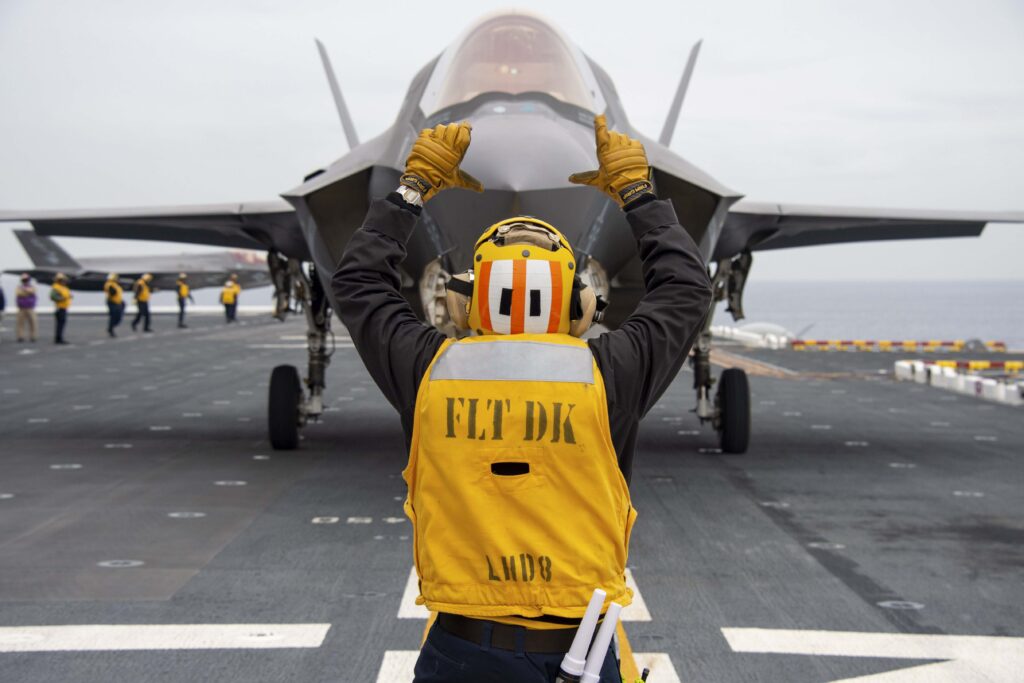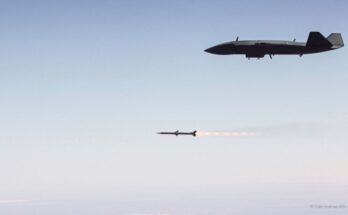 Source: U.S. Navy
Source: U.S. NavyThe Marine Corps recently released its 2025 Aviation Plan, outlining its visions for the future of Marine Aviation. The plan emphasizes a balance between maintaining readiness and investing in modernization and advanced technologies to ensure the force remains agile and lethal in the face of evolving global threats.
Project Eagle
At the core of the plan is Project Eagle, a long-term strategic path that aims to redirect resources over the next three Future Years Defense Programs (FYDP), the label provided for the military’s annual five-year spending plans. Project Eagle is laid out with four lines of effort:
- Focus on the viability of Distributed Aviation Operations (DAO) and Decision Centric Aviation Operations (DCAO). DAO moves the force away from centralized basing that can be vulnerable to enemy attacks in favor of smaller, dispersed operations, while DCAO aims to capitalize on faster processing and analysis of sensor and battlefield data to inform aviation operations.
- Develop a framework that aligns Marine Aviation with modern military campaigns, including codifying Aviation Ground Support as a doctrinal function.
- Create a data-centric and digitally enabled force by leveraging developments in artificial intelligence and machine learning to facilitate improved decision making and operational efficiency
- Address specific priorities to ensure the development of future capabilities are fully funded across the next three FYDPs and beyond. Key areas of planned investment include unmanned logistics platforms, aircraft survivability, and manned-unmanned teaming
F-35 Restructure
The Aviation Plan restructures the Marine Corps’ planned mix of F-35B and F-35C fighters. While the combined number of aircraft planned remains unchanged at 420, the service plans to field a total of eight F-35C squadrons instead of four, increasing the number of F-35C carrier variants that will be procured. The program of record now includes 280 F-35Bs and 140 F-35Cs, compared to the earlier plan of 353 F-35Bs and only 67 F-35Cs. Squadron sizes are also being increased from 10 to 12 aircraft each. This shift reflects an increased focus on carrier operations in the Marine Corps’ future force structure.
New Aviation Logistics Support Ship
While the Aviation Plan is focused primarily on aircraft, the document outlined the need for a new aviation logistics support ship, dubbed T-AVB(Next). The Marine Corps currently utilizes a pair of aviation logistics vessels (SS Wright and SS Curtis) to provide maintenance support for helicopters and fixed-wing aircraft. These ships are expected to retire in the early 2030s, and the Marine Corps warns of a “critical shortfall” if a replacement isn’t pursued. Maintaining this logistics capability is essential to supporting future distributed operations.
Other Modernization Priorities
The Aviation Plan outlines ongoing efforts to continue modernizing existing platforms with advanced sensors, communication systems, and electronic warfare capabilities to enhance overall situational awareness, survivability, and lethality. For example, F/A-18s are being outfitted with AESA radars and electronic warfare improvements, and the MV-22B Osprey is undergoing various upgrades, such as improvements to the fleet’s Degraded Visual Environment (DVE) flight capabilities, survivability, and digital interoperability.
The Marines also continue to field MQ-9A Reapers as part of its Marine Air-Ground Task Force (Unmanned Expeditionary Medium-Altitude, High-Endurance (MUX MALE) program, which will eventually field a fleet of 18 aircraft. A second increment of the MUX MALE effort involves developing and fielding new sensor capabilities for the MQ-9As. The fleet is expected to be fully operational with Increment II sensors at the end of FY30.
The Aviation Plan also prioritizes the modernization of Marine Aviation Enablers, which are critical components that facilitate and support aviation operations. Modernization efforts include updates to tactical air command and control, air defense, air traffic control, and aviation ground support. Key enabling technologies include the TPS-80 Ground/Air Task Oriented Radar (G/ATOR), Common Aviation Command and Control System (CAC2S), Composite Tracking Network (CTN), Medium Range Air Defense Radar (MRADR), Medium Range Intercept Capability (MRIC), and the Marine Air Defense Integrated System (MADIS).
By refining its aviation force structure, investing in next-generation capabilities, and enhancing its logistics and sustainment infrastructure, the Marine Corps aims to ensure its aviation forces remain a dominant force in future conflicts. As the service continues to implement these initiatives, its ability to operate effectively in contested environments – whether from expeditionary bases or carrier decks – will be a key factor in shaping the future fight.
Shaun's deep-rooted interest in military equipment continues in his role as a senior defense analyst with a focus on the United States. He played an integral role in the development of Forecast International's U.S. Defense Budget Forecast, an interactive online product that tracks Pentagon acquisition programs throughout the congressional budget process. As editor of International Military Markets – North America, Shaun has cultivated a deep understanding of the vast defense markets in the United States and Canada. He is a regular contributor to Forecast International's Defense & Security Monitor blog and has co-authored white papers on global defense spending and various military programs.
image sources
- Makin Island Underway: U.S. Navy



